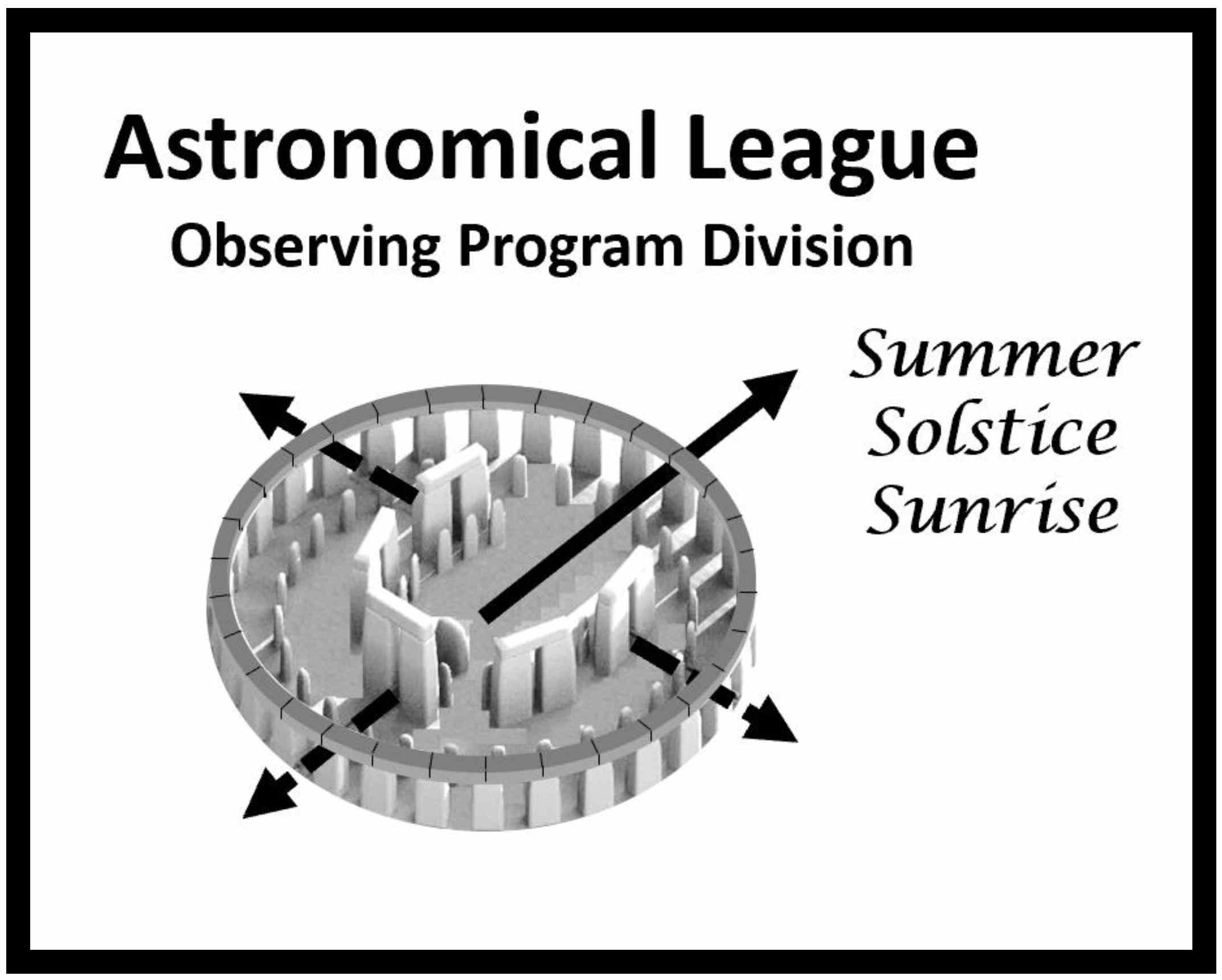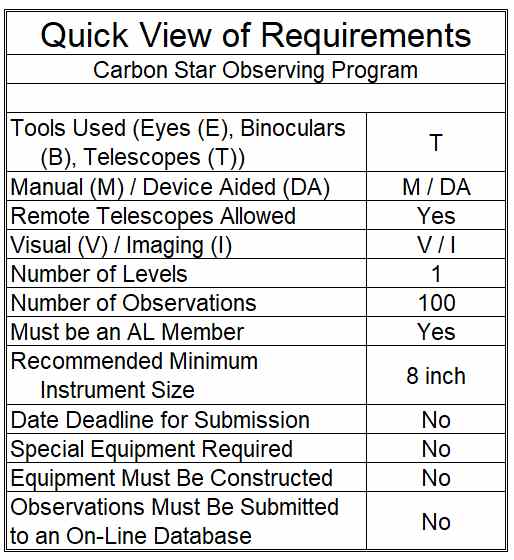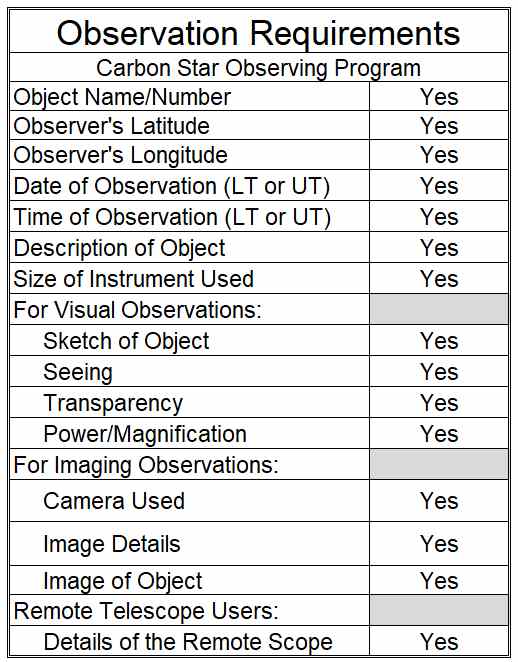Carbon Star Observing Program Coordinator:Robert “Rocky” Togni
|
 |
Introduction
| Welcome to the Astronomical League’s Carbon Star Observing Program!
Carbon stars are a unique and interesting type of variable star that exhibits peculiar characteristics and spectra. Most are red giant stars, and their distinguishing feature (and namesake) is the unusually high level of carbon molecules contained in their atmospheres. They are fascinating objects to observe, as their appearance may change dramatically during the course of their variation period. While these stars are popularly known for their striking red color, there is a wide range of possible hues that they may display. For the long-period variables or for those with large magnitude ranges, the apparent color may vary from yellow or orange at maximum to deep orange or red at minimum. The stars with shorter periods may remain at an almost constant color, and they often appear pale yellow or white. While these stars are relatively little-known in comparison to the brighter and more famous galaxies and nebulae, their vivid colors are unparalleled by most other observable objects. This distinctiveness, combined with their unusual characteristics, makes them fascinating subjects for observation, and we hope that through this program you will discover and enjoy these intriguing features for yourself. |
 |
Requirements and Rules
This certification is available to members of the Astronomical League, either through their local astronomical society or as members at large. If you are not a member and would like to become one, check with your local astronomical society, search for a local society on the Astronomical League Website, or join as a Member-At-Large at the AL Store.
| To obtain your certificate and pin for this program, please purchase the Guide to the Carbon Star Observing Program (available at the Astronomical League store). This manual includes the carbon star observing list, star charts and descriptions of the appearance of each entry, an observation log template, and an overview of the dynamics and composition of carbon stars. Excellent background information.
The carbon star observing list featured in this program is the product of many hours of painstaking research, observations, and compilation; and was created with the backyard observer in mind. All of the stars included are between magnitude 8.5 at maximum brightness and 14.0 at minimum, no complex or expensive equipment is required to complete this observing program. All of these stars are visible through a moderate-sized telescope, and many can be found in considerably light-polluted locations. Aaron Clevenson, who helped with the development of this program, logged a great deal of them from the backyard of his house – surrounded by bright streetlights – with skies heavily permeated by the glow of Houston, TX. To complete the program, the participant must simply observe and log each of the 100 carbon stars featured on the observing list. Please note that all observations should include this basic information: |
 |
- Observer’s name
- Object name
- Date/Time (local or Universal Time)
- Observing Site (Latitude and Longitude, and location)
- Sky conditions (Seeing, Transparency, Moon Phase, etc.)
- Telescope used
- Eyepiece used
- Magnification
- A detailed description of the object, including perceived color
- Sketch or image of the object (should include at least 5 identified field stars, if possible)
Observation Logs: An observation log template containing these fields is available in the Guide to the Carbon Star Observing Program. Below is also an observing log you can print out and turn in when complete. Any other log form of your choosing may also be used, as long as it contains the required information.
Go-To Scope: While “go-to” telescope systems are allowed for submissions, they are not recommended. Rather, traditional star-hopping or setting circle methods are suggested and enthusiastically encouraged for the completion of this list, as they require the observer to truly learn the sections of the sky they are exploring; an effort which gives a greater sense of personal achievement once the object is successfully located.
Sketching / Imaging: Sketching is required due to the difficulty in determining some of the stars. Primarily the carbon stars and key stars that identify the field are all that need to be sketched. If you prefer to image the stars, that is ok, but the other information, including color, is also required and must be done using your eyes through an eyepiece. Please identify the carbon star and some of the field stars in your image or sketch.
Alternative Source and Opportunity: Many carbon stars stand out in the field of view with their strong yellow to red color. Other times, carbon stars are difficult to identify without an accurate chart. Most of the stars listed are variable stars and variable star charts can be printed from the AAVSO (American Association of Variable Star Observers) website using the VSP (Variable Star Plotter). These include comparison stars so that a magnitude estimate can be made. If you like, you can create an account and submit your observations to AAVSO. Warning: You may want to do the Variable Star Observing Program or the Nova Observing Program next.
Submitting for Certification
| To submit your observations, either send COPIES of your logs to the Carbon Star Observing Program Coordinator, along with your name, mailing address, astronomy club or Astronomical League affiliation, e-mail address, phone number, and the person to whom the certification should be sent; or have them reviewed and approved by an officer of your astronomy club who should then notify the Carbon Star Observing Program Coordinator through email. Please do not send your original logs, as they will not be returned. Upon the reception and verification of the observations by the Coordinator, a certificate and award pin will be sent to the address provided, or to the Awards Coordinator of your club for presentation (if requested). |  |
Good luck and enjoy these stellar jewels.
Upon verification of your submission and of your active membership in the Astronomical League, your recognition (certificate, pin, etc.) will be sent to you or to the awards coordinator for your society, as you specified. Your name will also appear in an upcoming issue of the Reflector magazine and in the Astronomical League’s online database. Congratulations. Good luck with your next observing challenge.
Please send your submission to:
Carbon Star Observing Program Coordinator:
876 Copperfield Cove
Heber Springs, AR 72543
eaquilae@hotmail.com
Links:
- List of Carbon Stars to Observe as a PDF or as a Spread Sheet
- Carbon star log (PDF)



